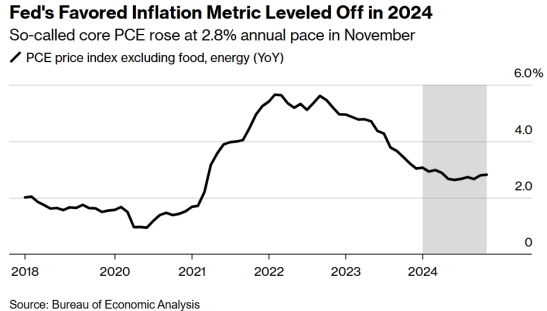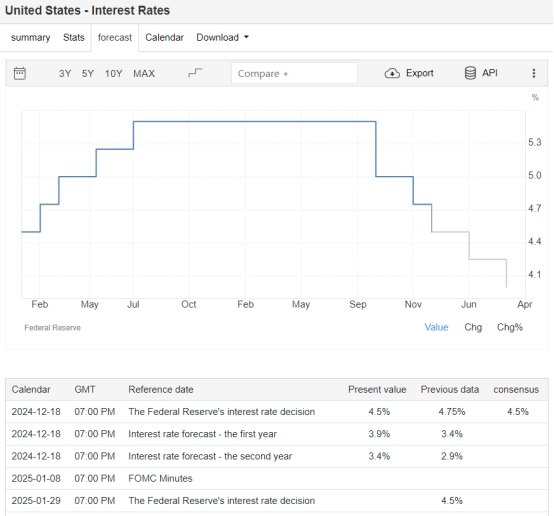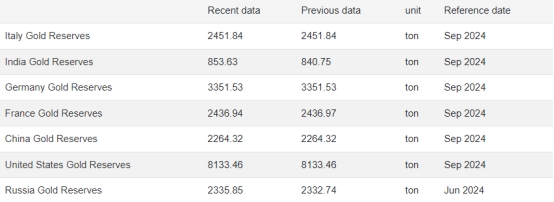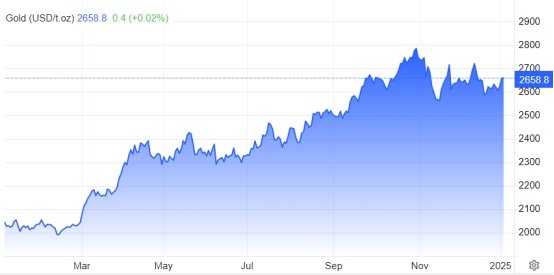Global monetary policy, geopolitics and demand dynamics – triple drivers for gold
- 2025年1月13日
- Posted by: Macro Global Markets
- Category: News

Macro Global Markets: 2024 will undoubtedly be a spectacular year for the gold market. Rising geopolitical tensions, rising consumer demand for gold in Asia, and strong central bank purchases of the precious metal have pushed gold prices to 41 new closing records in the first ten months, reaching $2,790/$ at the end of October. All-time high in ounces. Although gold's momentum stalled at the end of last year as Trump won the U.S. election, boosting risk assets and the U.S. dollar, State Street believes gold prices still have room to rise in 2025. The bank expects gold prices to fluctuate between $2,600 and $2,900 per ounce in 2025, with the potential to even rise to $3,100 per ounce.
For many analysts, the Fed's monetary policy remains the dominant force in global financial markets as it struggles to find a balance between continued inflationary pressures and supporting economic activity. In the final weeks of 2024, the Federal Reserve’s monetary policy expectations have undergone drastic changes. At its last monetary policy meeting on December 19, the Fed hinted that it would cut interest rates only twice next year; in its updated economic forecast in September, the Fed had expected that four interest rate cuts were possible. Analysts noted that the shift in Fed policy was justified as the economy is expected to remain relatively healthy through at least the first half of the new year. Most major investment banks have cut their forecasts for interest rates. Bank of America's fixed-income analysts are in line with the Fed's expectations, predicting only two rate cuts next year. Wells Fargo is slightly more hawkish, predicting only one interest rate cut in 2025.

BlackRock, the world's largest fund management company, is betting on the uniqueness of the United States and continues to increase its investment in U.S. stocks. Analysts at BlackRock noted that the U.S. economy remains in the best position to benefit from "superpowers" in the economy, especially the rise of artificial intelligence, which have upended traditional business cycles. "We believe investors should focus more on themes rather than broad asset classes as superpowers are reshaping the entire economy," the analysts said. "We believe the U.S. remains prominent among other developed markets, driven by stronger Growth and the ability to better leverage superpowers. With aggressive interest rate cuts, bond yields will continue to rise in 2025.
Not all analysts believe the U.S. economy can withstand the geopolitical uncertainty and unintended consequences of Trump's proposed policies. Before Trump took office, he threatened to impose trade tariffs on nearly all major economies in the world. While tariffs may help boost domestic manufacturing and support the dollar, these policies will come with costs and could exacerbate ongoing inflationary threats. In this environment, fixed income analysts at TD Securities are slightly pessimistic about the U.S. and global economies, and are more dovish about U.S. interest rates. They expect the Federal Reserve to cut interest rates four times in 2025, and the federal funds rate will be cut by the end of the year. down to 3.50%.

State Street Bank's 2024 study on gold ETFs showed that high-net-worth investors nearly doubled their gold allocation over the past year and viewed it as a safe-haven asset. State Street expects that even if the capital market shows a risk-on trend in 2025, this trend will continue. Gold's price support factors and its status as a safe-haven asset will continue to enhance its attractiveness as a core portfolio asset. Will a stronger dollar hurt gold? Gold is a dollar-denominated asset, so a strong dollar can sometimes be a headwind. But over the past few years, that pattern has been broken by unprecedented central bank buying. Since 2022, central banks are estimated to have purchased a total of 2,700 tons of gold, close to the fastest pace in history. Central banks have continued to buy gold even as dollar-denominated prices have soared over the past three years, suggesting they are more motivated by long-term strategic considerations and are not price sensitive. State Street expects central banks to continue to increase their gold reserves in the coming year.
Rising geopolitical tensions and moves by some countries to reduce the dollar's dominance in trade and global finance are also having an impact. Especially in emerging markets, central banks have been net buyers of gold for 15 consecutive years, diversifying their reserves that are mainly based in US dollars. The pace of those purchases began to accelerate when international trade relations deteriorated during Trump's first term. This sets the stage for more countries to consider foreign exchange diversification as a national security issue. In 2022, after the United States "weaponized" the dollar through financial sanctions against Russia, the central bank's gold purchase speed was once again "accelerated". Today, central banks in developed countries have also become open buyers of gold.

Another long-term driver of gold demand comes from the Asia-Pacific region. Over the past three decades, the region's tremendous economic growth has raised per capita incomes and stimulated investment. From 1990 to 2023, the Asia-Pacific region’s per capita GDP more than doubled, and its contribution to global GDP growth increased from about a quarter to more than two-thirds. The number of gold funds in India and China has increased rapidly, sparking investor enthusiasm. In both countries, gold has important cultural significance, with consumers long viewing it as a store of value and protection against inflation. Since 2005, the number of gold funds in the Asia-Pacific region has increased from three to 128, attracting more than US$23 billion in funds.
U.S. monetary and fiscal policies in 2025 may also influence the direction of gold. Until the exact size of tariffs and tax policies becomes clear, their true impact will remain unknown. The Fed predicts further rate cuts in 2025, but the exact number depends on the strength of the economy and the extent to which fiscal policy increases inflationary pressures and the federal deficit. Fiscal deficits driven by government borrowing and spending create a set of economic conditions that are favorable for gold. These conditions include high inflation expectations, currency depreciation, and heightened uncertainty surrounding the government’s ability to repay its debts. When fiscal deficits and a loose monetary environment occur simultaneously, State Street expects that the opportunity cost of holding gold relative to buying Treasury bonds will decrease in 2025, enhancing its relative attractiveness as a safe-haven asset.

Gold prices could vary depending on changes in Trump administration policies. State Street believes that the following three scenarios may occur: Base case (50% probability): The potential trading range of gold is between $2,600-2,900 per ounce. Bullish scenario (30% probability): Gold prices will fluctuate between $2,900-3,100/oz. Bearish scenario (20% probability): If U.S. growth far exceeds expectations and the Trump administration's pro-business measures boost the manufacturing sector, gold will fluctuate between $2,200 and $2,600 an ounce.
